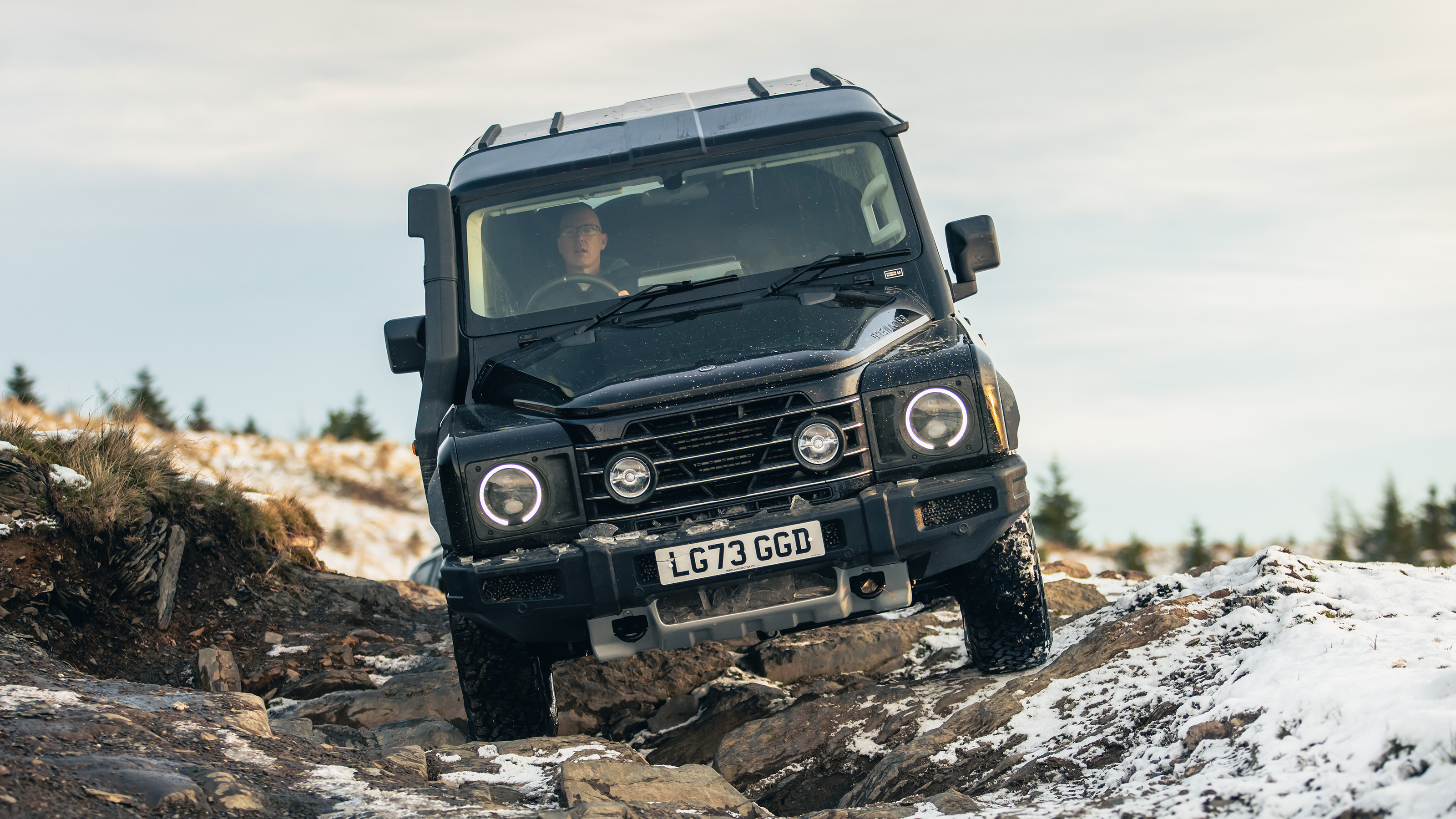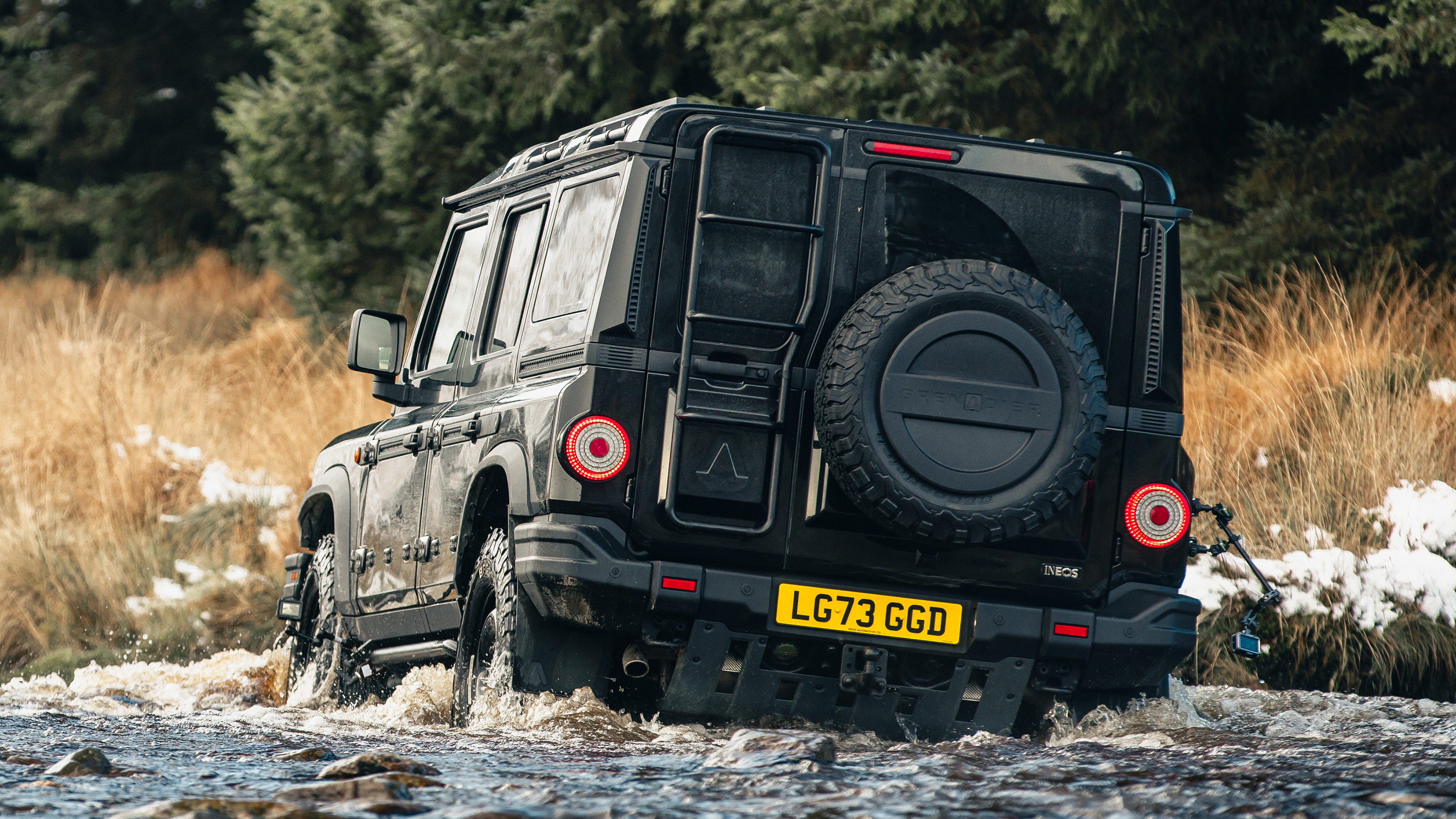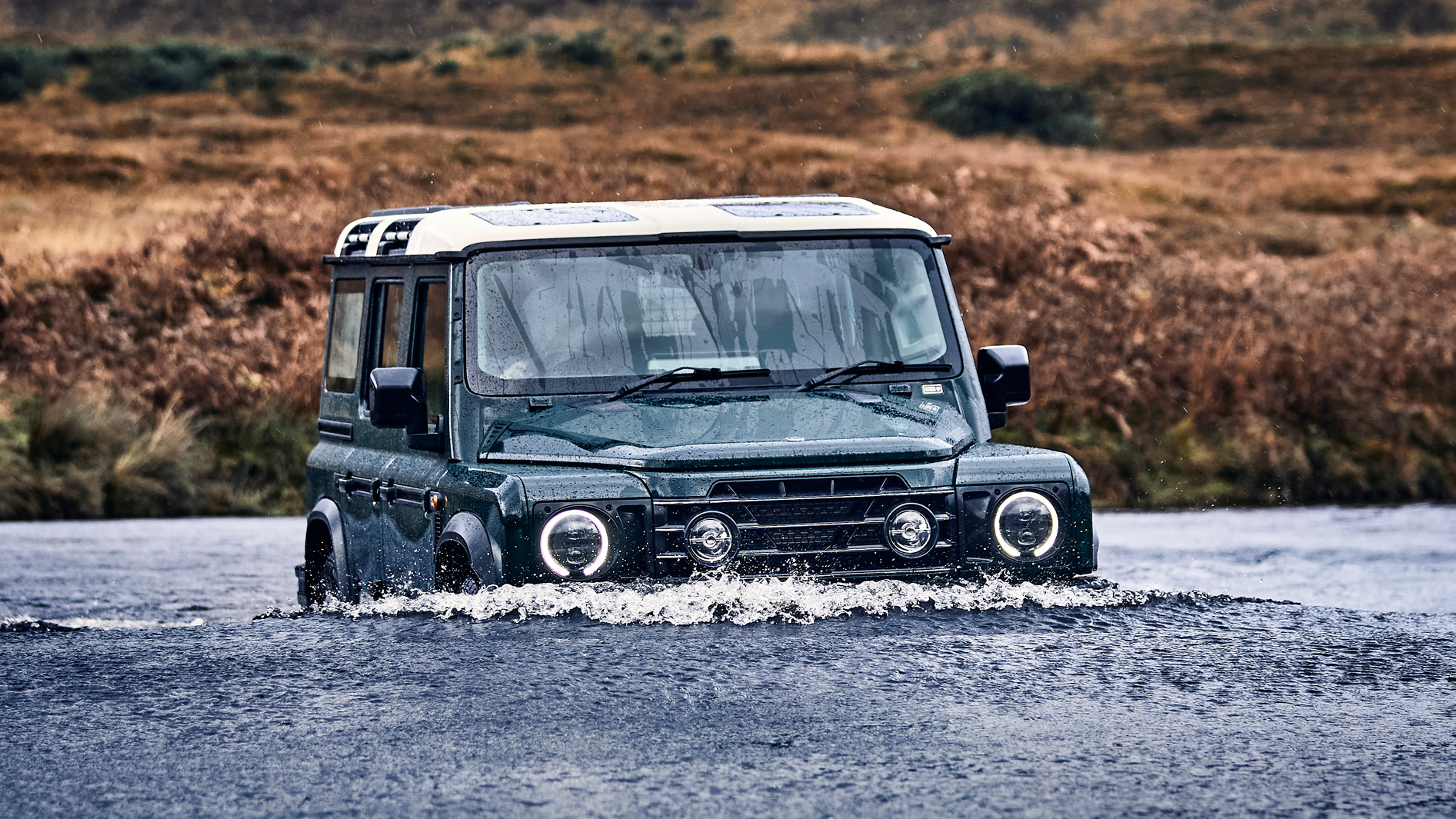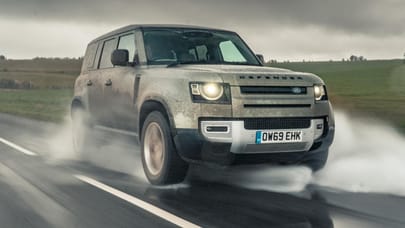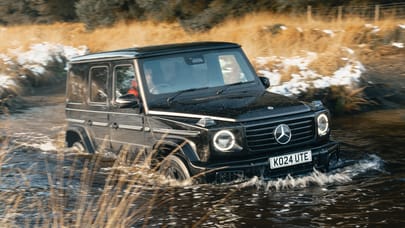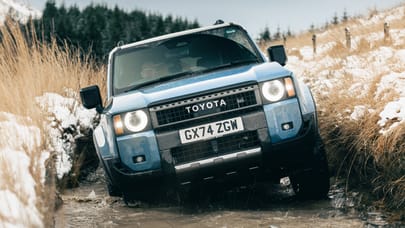
Good stuff
Amazing off-road, durable and robust, built tough, analogue feel and no lane assist
Bad stuff
Huge thirst for fuel, steering is awkward, passenger comfort, ponderous road manners
Overview
What is it?
You know those SUVs, with smoothly chamfered exteriors and mood-lit interiors, and perhaps even posh carpet in the foot-wells? Well, the Grenadier isn’t one of those. In fact, you can dispense with the S part of the SUV abbreviation. This is strictly a UV, or maybe a UUV – usable utility vehicle.
Ineos says it combines rugged British spirit and design with German engineering, for uncompromised off-road capability. It’s been a while since any manufacturer in this globe-straddling market segment used phrases like ‘no-nonsense’, ‘stripped back’, and ‘workhorse’ in the same sentence. But Ineos has.
Here’s another: fitness for purpose. The Grenadier is for people who run farms or drive across – and spend nights camped out on – African plains. No doubt plenty will end up clogging up the car park outside Daylesford Organic in the Cotswolds, but that’s not the Grenadier’s natural habitat.
Got it. But before we go on… Ineos? Who’s that?
The world’s third largest chemical company. It employs 26,000 people across 36 individual businesses, and has 194 manufacturing facilities in 29 countries. Lately, it has moved into the energy market – oil and shale gas – and is pretty keen on fracking (boo/hiss). But Ineos is also a massive mover and shaker in global sport, and owns a third of the Mercedes-AMG Formula One team, runs the Ineos Grenadier Cycling team, bank-rolled Sir Ben Ainslie’s America’s Cup sailing campaign (F1 on the ocean, basically) and owns a quarter of Manchester United. And yes, you could view all of this as sports washing.
But unless you really have been hiding under a huge rock these past few years, you’ll surely have heard of Ineos's owner, Sir Jim Ratcliffe. He’s Britain’s richest man – his estimated net worth was just over £29bn as of May 2023. The important thing to know about Ratcliffe is that he’s an adventurer. He’s sailed the northwest passage, ridden a motorbike along the spine of the Andes, been to both poles and climbed a variety of mountains.
Football clubs. F1. Racing yachts. It’s all a long way from building an old-school off-roader. Is this all relevant?
It is. Because Ineos is a disruptor, and has invested £1.3bn building its own off-roader because Ratcliffe thought there was a gap in the market, and didn’t think what’s currently available is up to the job. Cough, Defender, cough. And back in 2016 he tried to buy the old Defender production line from Land Rover, but was refused. On smaller slights have rivalries begun. Basically, he’s built a car for himself – a car for adventure.
Right, the car. Tell us more, please.
In terms of the visuals, no-one’s reinventing the wheel here, despite starting from a clean sheet. Ratcliffe cites design as one of the key attributes, but takes a dim view of the way Land Rover has reinvented the Defender. The Grenadier is unrepentantly boxy, primarily to maximise interior space, with a wheel at each corner to reduce overhangs, making off-roading easier (and less expensive when things go awry). The wheelarches are the shape they are to allow for maximum axle articulation. The front wings are flat so you can rest a mug of tea or a laptop on them.
Exterior wiring, with exit points to the roof at the front and rear, allows auxiliary lighting to be fitted. A utility rail with a universal fixing system on the doors is an option. A single-piece tailgate would have needed hinges the size of the moon to support it so the rear door is split 30:70. Open them both and there’s room for a Euro pallet inside. A lockable storage box is an option. The rear ladder can cope with 150kg of bodyweight. So too the roof, even without the full length rack fitted.
“There’s a kindness about these sorts of vehicles, even if they’re working cars,” designer Toby Ecuyer (a former yacht designer, he’s now the Ineos group’s full-time in-house design boss) explains. “Words like ‘faithful’ and ‘dependable’ crop up a lot. It’s not about grace or elegance. The vehicle had to be uncomplicated visually and uncomplicated to use. They’re easy to read, these things, you can see how they work just by looking at them.”
One designy note: the circular lights look great, and they’re the same size front and rear. The idea is to suggest the strength of a solid tube across the length of the vehicle. And although there are exterior door hinges, the actual bolts are inside to stop light-fingered sorts from unbolting them. The marketing team have also had fun with the colour palette: Scottish White was almost called Scottish Tan (geddit?), Donny Grey is a nod to Doncaster’s skies (Ineos co-founder Andy Currie is from that fine city), and there’s also Magic Mushroom (yes, it’s named after the psychedelic fungi).
Please note, the options list is long – we’d have the front winch from NATO-supplier Red Winches, although it costs £5,500 – and Ineos is happily ‘open source’ and encourages personalisation. There’s little point trying to critique what’s basically a box on wheels, but for all it owes a clear debt to the original Defender and G-Wagen, it also has lots of character of its own. Fitness for purpose is always cool, right?
What about the engines and specification?
We’re talking old-school ladder frame chassis (supplied by Gestamp in Germany), coilover suspension, and beam axles (from Italian specialist Carraro, who supply the likes of John Deere). The chassis has been fully e-coated for maximum corrosion protection, and the steel section is up to 3.5mm thick in the key places. Apparently the team spent three years working on it, which is a long time developing a ladder frame. There are front and rear skid-plates and protection for the 90-litre fuel tank.
Two powertrains are available, both sourced from BMW: the 3.0-litre turbo petrol is good for 283bhp and 332lb ft, the common rail direct injection turbodiesel 248bhp and 405lb ft. Ineos designed the manually adjustable two-speed transfer case, but it’s made by Tremec. In addition to its centre diff, two electronically actuated diff locks, supplied by Eaton, are also available. They’re optional, which suggests that Ineos is confident about the Grenadier’s ability in all but the toughest conditions.
The eight-speed ZF automatic is the one widely used in the car industry, but recalibrated here and fitted with a heavy duty torque converter. Ineos's engineering partner on the Grenadier, Magna Steyr, honed everything across a 1.1 million-mile development programme. Including the infamous Schoeckl mountain in Austria, a particular favourite of Sir Jim’s.
TG asks him whether it’s been more or less difficult getting the Grenadier done than he’d anticipated. “Oh, it’s been much more difficult,” he replies with zero hesitation. “We never got close to canning the whole thing, although we finished up spending a bit more money.”
Ratcliffe is a noted Brexiteer, whose vast income led him to decamp to tax-friendly Monaco a few years ago. The Grenadier, once tipped to be made at a factory in Bridgend, is built at the ex-Smart factory at Hambach in Eastern France.
What about potential rivals?
We’ll let Sir Jim go first: “There really isn’t anything in this space, is there? Other than pick-up trucks. If you’re a farmer or want to drive across Africa, what do you buy? Bits would fall off a Jeep. Drive the Grenadier in Africa and it’s better than anything else in terms of comfort and durability. Land Rover’s reliability is bad, the Land Cruiser reliable but looks average and it’s not very comfortable. So for the Grenadier we tried to create something that looks quite cool, has the reliability of the Toyota, and off-road capability that’s as good as it gets.”
It's a global car, in other words, designed to explore and cope with harsh environments. But there’s a reason people in those areas buy Land Cruisers, and it’s not just that they’re reliable. They’re built tough yet simple to fix, parts supply is extensive and affordable and they’re very capable. We should also point out that Sir Jim’s comment about them looking average came before the new Land Cruiser 250 was announced. That car is perhaps the Grenadier’s most significant global rival.
What does the Grenadier cost?
More than was originally planned, making a slight mockery of Sir Jim’s claim that it goes up against pick-up trucks such as the Ford Ranger and Toyota Hilux. Initially expected to retail for under £50,000, it actually costs from £76,000.
What specs does it come in?
You can have the Grenadier as a Station Wagon, a Utility Wagon (basically a posh van with either two or five seats) or as a pickup called the Quartermaster. Two main trims are offered, Fieldmaster and Trialmaster, the former being the more luxury oriented with Halloween wheels, leather trim and opening roof lights, while the Trialmaster comes with a raised air intake snorkel and the locking front and rear differentials mentioned above. A smaller, pure EV called the Fusilier was in development for a while, but has now been put on hold.
How does it drive?
The best way to put it is that it’s a very good update of an old Defender. It still has a fair few quirks, not least the recirculating ball steering, but the engines are strong and ride comfort is pretty good. You could do distance in this without too much bother. Except for the fuel costs, given the diesel has a WLTP figure of 23.1mpg. Off-road, it’s a complete beast, massively capable and very solidly built. It should hopefully earn a reputation for reliability.
What's the verdict?
Most start-ups are electric or dreamers making low-volume, often pointless sports cars. The Ineos Grenadier is indivisible from the man who owns the giant company that makes it, a pioneer who thinks big and tends to get things done. This automatically makes it fascinating, even if the end result isn’t exactly ground-breaking. Sir Jim Ratcliffe has simply built a car in his own image, to do the kind of things that he likes to do.
But we’re back to that fitness for purpose thing. The Grenadier is exceptionally well-engineered and does exactly what it sets out to do: go places most cars can’t without falling apart, and do it with some imagination and a dose of British idiosyncrasy. It’s also far more accomplished on-road than the old Land Rover Defender that inspired it. A fully specced up version is worryingly expensive, but the Grenadier has bags of character and really is quite easy to fall for. Just remember it’s not a school run SUV.
The Rivals
Trending this week
- Car Review
BMW 1 Series
- Top Gear's Top 9
Nine dreadful bits of 'homeware' made by carmakers




